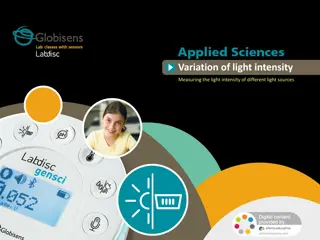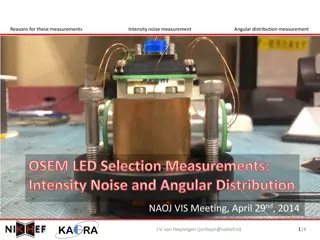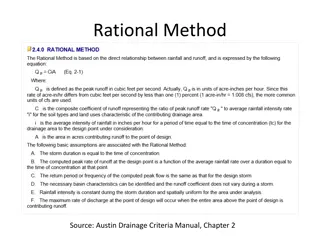Insights into Raindrop Size Distribution and Precipitation Intensity through Radar Technology
Vertical momentum of impacting raindrops can be converted into an electric pulse to analyze raindrop size distribution. Disdrometers using video cameras can directly count raindrops for sizing. Radar technology provides superior data on precipitation accumulation and intensity by measuring radar ref
4 views • 9 slides
Improving Heat Rate Efficiency at Illinois Coal-Fired Power Plants
Heat rate improvements at coal-fired power plants in Illinois are crucial for enhancing energy conversion efficiency, reducing carbon intensity, and minimizing pollution. By increasing the heat rate/efficiency by 6%, these plants can generate more electricity while burning the same amount of coal. T
2 views • 11 slides
High-Intensity Sweeteners Market Projected to Reach $5.37 Billion by 2034
The global high-intensity sweeteners market is projected to experience significant growth through 2034. High-intensity sweeteners are widely used as sugar substitutes due to their ability to provide the desired sweetness without the calories. \n
0 views • 5 slides
High-Intensity Sweeteners Market Projected to Surpass $5.37 Billion by 2034
The High-Intensity Sweeteners Market is projected to reach $5.37 billion by 2034, growing at a CAGR of 5% during the forecast period from 2024 to 2034.\n
0 views • 4 slides
Classification Keys for Identifying and Sorting Things
A classification key is a tool with questions and answers, resembling a flow chart, to identify or categorize things. It helps in unlocking the identification of objects or living things. Explore examples like the Liquorice Allsorts Challenge and Minibeast Classification Key. Also, learn how to crea
3 views • 6 slides
Basics of Fingerprinting Classification and Cataloguing
Fingerprint classification is crucial in establishing a protocol for search, filing, and comparison purposes. It provides an orderly method to transition from general to specific details. Explore the Henry Classification system and the NCIC Classification, and understand why classification is pivota
5 views • 18 slides
Earthquakes: Causes, Effects, and Intensity Factors
Earthquakes are sudden shaking movements of the Earth's surface caused by various factors like tectonic plate movements, volcanic eruptions, mining, and construction. They result in ground shaking, rupture, tsunamis, and landslides, with intensity influenced by factors such as distance from the epic
0 views • 10 slides
ROC Curves in Multiclass Classification
ROC curves are extended to multiclass classification to evaluate the performance of models in scenarios such as binary, multiclass, and multilabel classifications. Different metrics such as True Positive Rate (TPR), False Positive Rate (FPR), macro, weighted, and micro averages are used to analyze t
3 views • 8 slides
Guideline for Statin Management in High-Risk Groups - 2018 ACC/AHA
This guideline outlines the management of blood cholesterol in high-risk groups according to the 2018 ACC/AHA recommendations. It discusses the overall approach, different statin management groups, justification for statin use in high-risk populations, high and moderate-intensity statin therapy, and
1 views • 14 slides
Investigating the Effect of Light Intensity on Photosynthesis Using Pondweed
Explore the impact of light intensity on photosynthesis rates by conducting a practical experiment with aquatic plants like pondweed. Learn about the factors influencing photosynthesis and how to measure its rate effectively through counting oxygen bubbles produced. Follow a step-by-step guide to se
0 views • 12 slides
AI Projects at WIPO: Text Classification Innovations
WIPO is applying artificial intelligence to enhance text classification in international patent and trademark systems. The projects involve automatic text categorization in the International Patent Classification and Nice classification for trademarks using neural networks. Challenges such as the av
2 views • 10 slides
High-Intensity Sweeteners Market
The High-Intensity Sweeteners Market is expected to grow to $5.37 billion by 2034, with a compound annual growth rate (CAGR) of 5% over the forecast period from 2024 to 2034.\n
0 views • 3 slides
High-Intensity Sweeteners Market
With a projected value of $5.37 billion by 2034 and a CAGR of 5% during the 2024\u20132034 period, the High-Intensity Sweeteners Market is set for substantial growth. \n
0 views • 3 slides
Overview of Fingerprint Classification and Cataloguing Methods
Explore the basics of fingerprint classification, including Henry Classification and NCIC Classification systems. Learn about the importance of classification in establishing protocols for searching and comparison. Discover the components of Henry Classification, such as primary, secondary, sub-seco
1 views • 21 slides
Light Intensity Variation in Different Sources
Explore the correlation between light intensity and efficiency in various light sources through an intriguing experiment. Delve into the theoretical framework and practical applications to grasp the essence of light intensity and its distribution. Uncover the factors influencing the efficiency of li
0 views • 21 slides
7th IOTA/FAST Collaboration Meeting & Workshop on High-Intensity Beams
The 7th IOTA/FAST Collaboration Meeting & Workshop on High-Intensity Beams in Rings, led by Alexander Valishev, featured discussions, emergency procedures, logistics, and a structured meeting agenda focusing on experimentation, research, and future opportunities.
0 views • 4 slides
Light Intensity: Measuring Different Light Sources
Explore the concept of light intensity by measuring various light sources and their efficiency. Through practical experiments, understand the relationship between light intensity and the output of different light sources. Theoretical frameworks, practical applications, and key concepts are discussed
0 views • 21 slides
Laser Beam Propagation in Maritime Environment Study
Investigation and comparison of laser beam propagation in maritime environments through field and laboratory experiments. The study examines the effects of real-life conditions such as temperature fluctuations, wind, and aerosols on laser light propagation. A basic field experiment at the US Naval A
0 views • 11 slides
Fluctuating Intensity of Laser Beam in Marine Atmospheric Turbulence
Probability Density Function (PDF) reconstruction for the fluctuating intensity of a laser beam propagating in marine atmospheric turbulence involves experimental setup and calculations of statistical moments. Various models and methods are applied to reconstruct the PDF, crucial for solving inverse
0 views • 23 slides
Academic Intervention Library Overview
Explore the Intervention Library for academic and behavior interventions, accessed through OKMTSS. Filter interventions by grade band, intensity level, and group size. Understand grade band considerations and intervention intensity tiers. Learn about the recommended group sizes and how to choose the
0 views • 15 slides
Dynamics and Predictability of Super Typhoon Usagi's Rapid Intensification
Study on the rapid intensification of Super Typhoon Usagi in 2013, focusing on the role of moisture, ensemble forecasting, data assimilation, and factors affecting intensity forecasts. The research explores the impact of environmental and internal factors on intensity divergence and timing variation
0 views • 21 slides
Ion Beam Intensity Enhancement Through Electron Heating in Collider Experiments
The study discusses electron heating of ions in collider experiments at the Collider V. ParkhomchukBINP facility in Novosibirsk. It explores the effects of electron cooling on ion beams, ion beam oscillations, losses, and ion beam intensity enhancement. Various factors such as ion charge, classical
0 views • 9 slides
High-Intensity Sweeteners Market
By 2034, the global high-intensity sweeteners market is set to reach $5.37 billion in value and 110,871 tons in volume.\n
1 views • 4 slides
Intensity Noise and Angular Distribution Measurements in LED Selection
The measurements focus on intensity noise and angular distribution to address variations in LED performance observed in LIGO papers. The study aims to investigate intensity noise dependence on LED current, differences between LED batches, and comparisons between them.
0 views • 8 slides
Chicken Wing Sauce Consumer Test Analysis
Analysis of consumer preferences and feedback on different chicken wing sauces based on overall liking, flavor intensity, garlic flavor intensity, honey flavor intensity, and amount of sauce. The study includes crosstabulations and mean graphs to evaluate category liking attributes and jar assessmen
0 views • 12 slides
Hierarchical Semi-Supervised Classification with Incomplete Class Hierarchies
This research explores the challenges and solutions in semi-supervised entity classification within incomplete class hierarchies. It addresses issues related to food, animals, vegetables, mammals, reptiles, and fruits, presenting an optimized divide-and-conquer strategy. The goal is to achieve semi-
1 views • 18 slides
Intensity Feedback System for Laser Beam Control
The intensity feedback system aims to maintain stable beam current and investigate DC gun performance. Using motor-controlled half wave plates and electro-optical modulators, the system achieved 2% rms stability. Initial measurements with photodiodes revealed challenges, but signals from the gun tab
0 views • 14 slides
Wake Fields and Electron Cloud in High-Intensity Proton Rings
Investigating wake fields and electron cloud phenomena in high-intensity proton rings is crucial for understanding instabilities and improving accelerator science. This involves experimental studies, analyzing instabilities, controlling wake amplitudes, and protecting future machines operating in st
0 views • 22 slides
Classification in Data Mining
Classification in data mining involves assigning objects to predefined classes based on a training dataset with known class memberships. It is a supervised learning task where a model is learned to map attribute sets to class labels for accurate classification of unseen data. The process involves tr
0 views • 26 slides
Slovenia's R&D Success: Achieving Growth Through Innovation and Synergies
Slovenia has made significant progress in increasing research and development (R&D) intensity, positioning itself as a top performer in the EU. With a focus on stimulating innovative SMEs and public-private partnerships, the country is on track to meet its 2020 R&D intensity target. Challenges remai
0 views • 12 slides
Allogeneic Hematopoietic Stem Cell Transplantation Overview
This presentation discusses the current status and future directions of hematopoietic stem cell transplantation, focusing on autologous and allogeneic procedures, different sources of stem cells, and various conditioning regimens. It delves into how myeloablative allogeneic bone marrow transplantati
0 views • 32 slides
Austin Drainage Criteria Manual - Chapter 2 Resources
This collection of resources includes information on the Rational Method, Mannings N values, and Intensity-Duration-Frequency Curves from the Austin Drainage Criteria Manual Chapter 2. The Rational Method source and key data such as precipitation intensity and duration are highlighted with detailed
0 views • 4 slides
High-Intensity Sweeteners Market
The high-intensity sweeteners market is on track to reach $5.37 billion and 110,871 tons globally by 2034, with projected CAGRs of 5% in value and 2.9% in volume over the period from 2024 to 2034.\n
0 views • 4 slides
Flagship Project on Reducing GHG Intensity of Rice Systems
This project aims to find practical measures to reduce emission intensity of rice systems while improving production efficiency. Components include water and organic matter management, cultivar selection, and modeling. Projects focus on improving water management techniques in American and Asian ric
0 views • 6 slides
Factors Affecting Algal Ecology: Light Intensity Impacts on Algae Growth and Composition
Light intensity plays a crucial role in the growth and composition of algae. Algae undergo photoadaptation processes to adjust to varying light levels, affecting their photosynthetic efficiency and cellular properties. High light intensity can lead to photoinhibition and changes in cellular composit
0 views • 19 slides
Real-time Intensity Forecast Error Prediction Project
This project aims to provide real-time guidance on forecasting intensity errors of hurricanes by using regression formulas based on proxies and atmospheric conditions. The research focuses on relating forecast errors to initial conditions, environmental stability, and dynamical predictors to improve
0 views • 48 slides
Machine Learning Applications for EBIS Beam Intensity and RHIC Luminosity Maximization
This presentation discusses the application of machine learning for optimizing EBIS beam intensity and RHIC luminosity. It covers topics such as motivation, EBIS beam intensity optimization, luminosity optimization, and outlines the plan and summary of the project. Collaborators from MSU, LBNL, and
1 views • 23 slides
High-Intensity Sweeteners Market
The global high-intensity sweeteners market is expected to grow to $5.37 billion and 110,871 tons by 2034, with value rising at a 5% CAGR and volume expanding at 2.9% annually from 2024 to 2034.\n
0 views • 3 slides
Challenges and Design of High-Intensity Accumulator for Neutrino Experiments
The presentation discusses the challenges faced in designing an accumulator for high-intensity particle beams in neutrino experiments at ESS Lund, with a focus on beam loss management, injection efficiency, and intense beam physics issues. The design considerations include beam holding capacity, bea
0 views • 30 slides
Robust High-Dimensional Classification Approaches for Limited Data Challenges
In the realm of high-dimensional classification with scarce positive examples, challenges like imbalanced data distribution and limited data availability can hinder traditional classification methods. This study explores innovative strategies such as robust covariances and smoothed kernel distributi
0 views • 10 slides







































